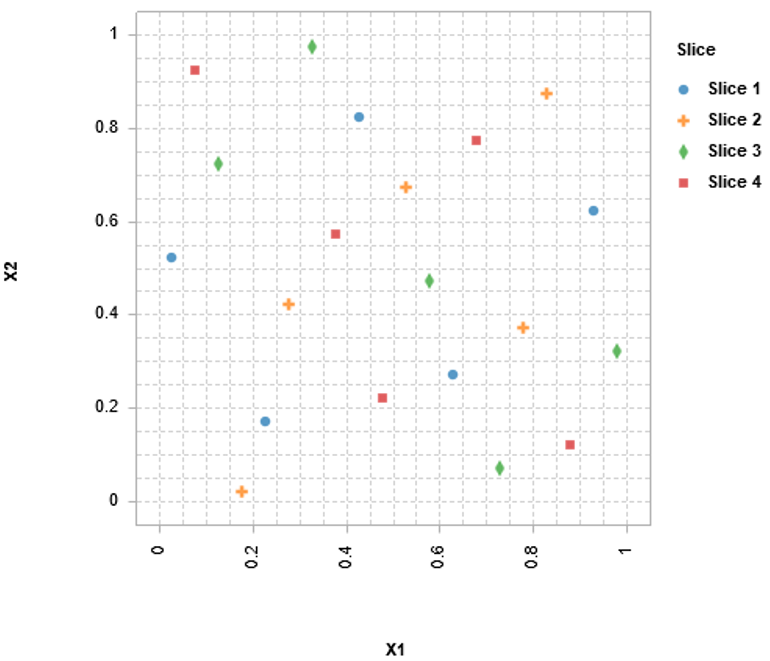

American Institute of Aeronautics and Astronautics Paper 1274.Ĭurrin C., Mitchell T., Morris M. (2002) Improved Distributed Hypercube Sampling. Supported design types are described in the documentation forīeachkofski, B., Grandhi, R. considered interestingįor computer experiments, where replications of the same settings are often useless. The lhs designs are useful for quantitative factors, if it is considered desirable to uniformlyĭistribute design points over a hyperrectangular space. Range coding is based on the recoding facility from package rsm and theįactor.names parameter used analogously to packages DoE.base and FrF2. Of recoding lhs samples to a desired range, and they embed the lhs designs into In comparison to direct usage of package lhs, the functions add the possibility Type optSeeded takes the existing sample as the starting point but potentially modifies it). Detailsįunction lhs.design creates a latin hypercube sample,įunction lhs.augment augments an existing latin hypercube sample (or in case of Please make sure to store important designs for the future, if needed (of course, this is always wise anyway!). Note also: Package lhs does not promise to keep designs reproducible between package versions.
#Latin hypercube design of experiments code#
(correction of a biased previous behavior that should not be relevant for the randomization of designs).įor using code that randomizes a design interchangeably between a new R version (3.6.0 or later)Īnd an older one, please follow the steps described with the argument randomize. Since R version 3.6.0, the behavior of function sample has changed These elements are only present to fulfill the formal requirements for class design. Replications is always 1 and repeat.only is always FALSE Standard second order methodology implemented in package rsm. Randomize is always TRUE for designs generated by random sampling, but may be FALSE forĭesigns created with type=fact or type=faure.Ĭoding provides formulae for making the designs comfortably usable with Quantitative is a vector of nfactor logical TRUEs,Īnd the digits elements indicates the digits to which the data were rounded.įor designs created with package DiceDesign, special list elements from this package design), the subtypeĮlement indicates the type of latin hypercube designs and possibly additional augmentations, the element In addition to the standard list elements (cf. The attribute is a list of various design properties, with type resolving to “lhs”. The augmented design preserves this reorder and also the respective numbering of the design. In case of lhs.augment, if the design to be augmented had been reordered before, In which package DiceDesign creates the design, and the actual run order may be different in case of It therefore is present for formal reasons only and contains three identical columns of 1,2.,nruns.įor designs created with type=fact or type=faure, the standard order is the order The attribute run.order is not very useful for most of these designs, as there is no standard order. The response data are NOT used in deciding about which points to augment the design with. Have been added to the design lhs before augmenting. The experimental factors in the matrix desnum attached as attribute desnum contain theĭesign in the unit cube (all experimental factors ranging from 0 to 1) asįunction lhs.augment preserves additional variables (e.g. Rounded to the number of digits given in digits (if given). The data frame contains the experimental settings as recoded to the scale ends defined in factor.names (if given), It is recommended to change the setting back to the new recommended way afterwards:įor an example, see the documentation of the example data set VSGFS.Īdditional arguments to the functions from packages lhsīoth functions return a data frame of S3 class design You have to change the RNGkind setting in the later R version by Run code interchangeably on R 3.6.0 and an earlier R version, If you work in a new (i.e., >= 3.6.0) R version want to In R version 3.6.0 and later, the default behavior of function sample If randomization is requested, the following information is relevant: Of the non-randomized design may be beneficial. Note that preventing randomization is the default here, because these designsĪre assumed to be used mostly for computer experimentation, where the systematics The option has an effectįor types fact and faure only. Logical that prevents randomization per default.


 0 kommentar(er)
0 kommentar(er)
